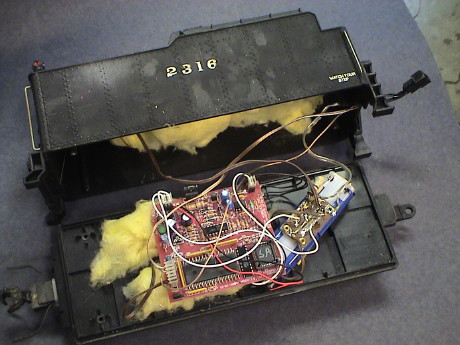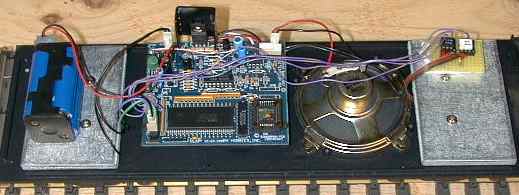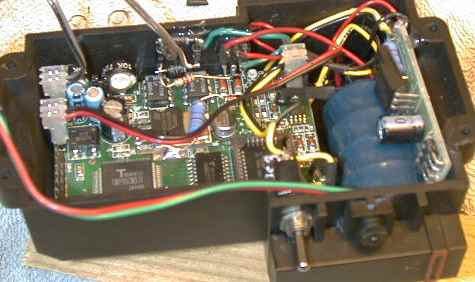 30 Nov 11
30 Nov 11[ Home ] [ Up ] [ Previous Page ] [ Next Page ]
 30 Nov 11
30 Nov 11This page is primarily here for historical purposes because PH Hobbies doesn't seem to be around anymore. Paul Housey was essentially PH Hobbies and I do not know what became of him.
Paul made his own sound systems that were sold directly to users. He also made OEM (Original Equipment Manufacturer) systems that he sold to Aristo with Aristo's part number on them. These were customized systems intended to fit directly into particular models of Aristo locomotives.
Overall, Paul's systems worked well and I still use all three that I originally bought in the late 90's. At that time, there weren't too many digital sound systems around and Paul's were among the least expensive of the lot. The sound quality was generally good. Although the systems lacked a little bit for the "features" that Phoenix and Soundtraxx Sierra had, they worked well enough.
Dallee was around at the time too and they were cost competitive with PH Hobbies, but I think that the older Dallee systems didn't sound quite as good, especially the steam versions, as the PH Hobbies systems did. As of 2009 or earlier, Dallee is providing "OEM" sound systems to Aristo.
 I believe that the first
digital sound system that I installed was the one that is still in
the tender of my Lionel
Atlantic. Originally it had no sound at all. This is a basic system with
a bell, whistle and chuff. The chuff, bell and whistle are
configured to be triggered by reed switches or DCC decoder
functions. I used optical isolators between the DCC decoder and the
sound system but they probably were not necessary. I could have
triggered the system directly from the decoder.
I believe that the first
digital sound system that I installed was the one that is still in
the tender of my Lionel
Atlantic. Originally it had no sound at all. This is a basic system with
a bell, whistle and chuff. The chuff, bell and whistle are
configured to be triggered by reed switches or DCC decoder
functions. I used optical isolators between the DCC decoder and the
sound system but they probably were not necessary. I could have
triggered the system directly from the decoder.
The system produces basic sounds. A compressor runs while standing, it blows two toots when it starts to move (forward or backward) and a fair sounding chuff while it is running. The shortest whistle sound is too long to be "played" adequately but at least it sounds good. The volume is adequate for outdoor use, I don't turn it all the way up. Volume is manually set with a volume control that you have to mount somewhere.
The system has a backup battery to allow it to play while standing on unpowered track. It uses 4 NiCad or NiMH AA cells mounted in a conventional battery holder. It needs good batteries because bad ones have a higher impedance and the system required a low impedance power source to prevent from picking up DCC noise from the track or even a local AM radio station. Even now, if I touch the volume control shaft, I can hear KNX.
 The old (1990's vintage) Aristo Pacific came with a very
basic analog sound system in the tender. This system barely worked
but it did make the marketing claim of "sound equipped" legal. It
never sounded very good and I ripped it out in favor of an PH
Hobbies OEM ART-29341 digital sound system. At that time, Phoenix
cost about 2.5x that of the PH system. It was a PH S3005 generic
steam system but configured to fit into the Aristo tender and to
use the Aristo Hall effect chuff trigger.
The old (1990's vintage) Aristo Pacific came with a very
basic analog sound system in the tender. This system barely worked
but it did make the marketing claim of "sound equipped" legal. It
never sounded very good and I ripped it out in favor of an PH
Hobbies OEM ART-29341 digital sound system. At that time, Phoenix
cost about 2.5x that of the PH system. It was a PH S3005 generic
steam system but configured to fit into the Aristo tender and to
use the Aristo Hall effect chuff trigger.
This system is very similar but not identical too the S3005 generic system. It has different recordings in it and it doesn't play two toots when starting out. Other than that, it works pretty much the same as the S3005.
 The system that PH Hobbies built
for the 1st generation RS3 was a custom job, the ART-29338. It was
configured and delivered in an RS3 fuel tank. The intent was that
the user would remove the stock fuel tank and simply replace the
whole thing. There were connectors to reach to the little
distribution board in the loco so that it could get power. The loco
also came with a speaker that had a harness and connector designed
to plug directly into the sound system.
The system that PH Hobbies built
for the 1st generation RS3 was a custom job, the ART-29338. It was
configured and delivered in an RS3 fuel tank. The intent was that
the user would remove the stock fuel tank and simply replace the
whole thing. There were connectors to reach to the little
distribution board in the loco so that it could get power. The loco
also came with a speaker that had a harness and connector designed
to plug directly into the sound system.
The system came with a stack of button batteries stacked in the fuel tank. After 10 years, mine still take and hold a charge. There was a problem with keeping these batteries charged so PH Hobbies provided an external "booster" board to allow the batteries to charge while sitting on the track with the motors off. This worked fine when I installed DCC and I didn't have to turn off the motors.
The system makes a credible diesel engine sound and it stays in speed sync with the loco quite well. There are a triggerable horn, bell and "cab chatter" sounds. The system used a stereo audio power amp and it can be configured to drive TWO speakers to get more sound volume by splitting the engine and other sounds into separate channels that can then be turned up as they won't interfere with each other. I found that unnecessary, it has plenty of volume by itself so I run all sounds through one speaker.
The Aristo manual for the ART 29338 is here.
[ Home ] [ Up ] [ Previous Page ] [ Next Page ]
This page has been accessed times since 3 Sep 09.
© 2009-2011 George Schreyer
Created 3 Sep 09
Last Updated November 30, 2011